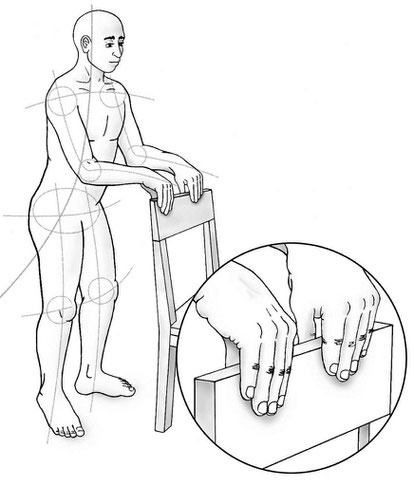DEFINING THE ALEXANDER TECHNIQUE Tim
Soar © 1999
27. Hands on the Back of the Chair
Alexander devotes an entire chapter1 to this procedure, describing it in detail which I need not reproduce. It is a complex procedure, which relies upon considerable skill and experience in maintaining a series of directions “all together, one after the other”.

Done well, hands on the back of the chair gives an added stimulus to the back (and particularly the upper back) to lengthen and widen through the demand made upon it to support the arms. It provides the experience of using the arms and hands as an integrated extension of the head/neck/back core of the body.
This is a useful experience for instrumentalists, computer operators, craft workers and others who use their hands skilfully and intensively. At an advanced level it can also give an insight into how the use of the hands (for holding and manipulating) has the potential to become an expression of the use of the whole self. This is the way in which good Alexander teachers use their hands whilst they are working, so it should not be surprising that Alexander used to tell his trainee teachers that this procedure could show them what they needed to know about using their hands to teach his Technique.
Hands on the back of the chair can be performed either in monkey, or sitting with the torso inclined forward from the hips to accentuate the antagonistic pull between the head and the pelvis. The top back rail of the chair should be fairly flat (in a vertical plane) and perhaps 90 cm from the floor.
The Procedure2
-
Stand neutrally about 30 cm behind the
chair, or sit (on a second chair) with the torso vertical and the feet flat on the floor near to the back legs of the chair in front of you.
-
Move into a monkey or (if sitting)
incline the torso forward from the hips by about the same angle that your torso inclines forward when in monkey.
-
Raise the hands (one at a time or both
together) to take hold of the chair rail so that:
-
The fingers are together, vertical and
straight.
-
There is a gap between the top edge of
the chair rail and your hand.
-
The thumbs oppose the tips of the index
fingers.
-
The wrists “point” slightly inwards
towards each other. This positioning of the hands encourages a particularly clear experience of the uniquely human ability to grip precisely between the pads of the thumb and
fingers.
A number of variations in the use of the hands is possible at this stage, according to your level of experience.
-
Simply maintain the position, aiming
gradually to eliminate all unnecessary effort.
-
Directing the elbows “outwards and
slightly downwards”l imagine the chair rail between the hands to be lengthening.
-
Apply an actual force with your hands,
such that, if the chair rail were made from elastic, it would be stretched.
1 Constructive Conscious Control of the Individual, FM Alexander, 1923, Part II, Chapter 4 “Illustration”.
2 Continuous inhibition and direction are assumed.